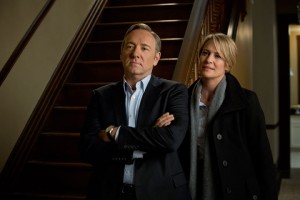
After more than 40 years of operation, DTVE is closing its doors and our website will no longer be updated daily. Thank you for all of your support.
The way we view now
As Amazon signs Woody Allen to make his first TV series, are on-demand services poised to wreck the broadcast model? Stephen Price is sceptical.
The traditional way of watching television, as a family around a static set in the corner of the living room, is over, we are told. TV ownership has – for the first time ever – declined.
Now it’s about subscription-based, on-demand content downloaded to watch when you want and where you want; we’ll all be binge watchers soon. According to this view, the way we watch TV is at, or even past, a tipping point. If only it were that simple.
Ofcom’s Infrastructure Report 2014, published in December, remarked that, while most television is still consumed through “traditional linear broadcasting platforms”, change is in the air – driven mostly by technology.
Consumers’ desire for higher-quality pictures and improved sound continues to grow. Ofcom noted that 69% of households now have HDTV, and that the focus is beginning to shift to ultra-HDTV in its 4K version. Yet the proportion of UK households with a TV is decreasing, albeit slowly. As ultra-HDTVs fall in price, it will be interesting to see if this trend continues.
Based on Barb data, Ofcom reported that nearly 1 million UK households are now also broadband-only. These homes get their programming via the internet and are perhaps more likely to watch the broadcasters’ and other players’ on-demand services. These, of course, include BBC iPlayer and ITV Player, plus IPTV services such as Netflix (more than 10% of UK homes are subscribers) or Amazon Prime.
One interesting result of this technological arms race has been the rise and rise of drama, a genre that, not so long ago, was considered an endangered species.
In 2008, as the economic crisis deepened, television, especially commercial television, looked as if it could no longer sustain this most expensive and risky of genres. Then, in the midst of the economic mayhem, ITV commissioned an original period drama. It was risky on every level: it was expensive, it wasn’t an adaptation of a famous book and there were seven episodes – a big commitment, if it didn’t work.
ITV had always done period drama – adaptations of Jane Austen’s Mansfield Park and Northanger Abbey in 2007, for example – but it wasn’t the channel’s speciality. Downton Abbey’s unlikely success meant that suddenly the genre was back in vogue.
It is no coincidence that subscription services such as Netflix and Amazon Prime have pinned their business plans on the creation of new, expensive dramas to attract subscribers.
Last month, Netflix reported revenues up by 23%, to US$1.5bn, during 2014’s last quarter, stronger than expected. It is unlikely that this would have happened without House of Cards (a US$200m commission for two series) or Breaking Bad (a one-programme marketing phenomenon that previously went unnoticed on Channel 5’s sister channel 5 USA).
Netflix’s latest £100m commission is The Crown, written by Peter Morgan and based on his successful stage play The Audience. The show is aimed squarely at middle-aged viewers.
In January, Transparent won two Golden Globes for Amazon Prime: Best TV Series and Best Actor in a Musical or Comedy Series for Jeffrey Tambor. Kevin Spacey won Best Actor in a Drama TV Series for Netflix’s House of Cards. Subscription on-demand providers are TV interlopers no more. And now Amazon has signed Woody Allen to write and direct his first TV series at the age of 79.
But broadcasters still boast a long list of high-quality TV drama of their own. In 2014 alone: BBC Two screened Line of Duty and The Fall; BBC One showed Happy Valley and The Missing; ITV continued with Downton Abbey and kicked off this new year with series two of Broadchurch. BBC Two’s Wolf Hall launched on 21 January of this year with nearly 4 million viewers and instantly became the channel’s most popular drama for a decade.
Undoubtedly, things are changing and on-demand TV is growing. But humble broadcast TV last year stubbornly accounted for 88% of all viewing. The signs are, for the time being, that traditional platforms will co-exist with the likes of Netflix and Amazon Prime.
Even the hardly impartial Reed Hastings, CEO of Netflix, predicts that traditional TV will be around for more than another decade. “It’s kind of like the horse, you know; the horse was good until we had the car. The age of broadcast TV will probably last until 2030,” he forecast last year.
There is no doubt that a House of Cards binge-watch can take up a wet Saturday afternoon before Strictly comes on. But one thing is certain, the quality of TV is rising and the viewer is the winner.
For the full article please see the February issue of the Royal Television Society’s members magazine, Television.



